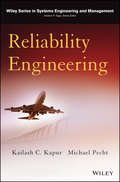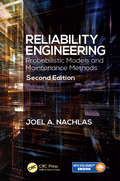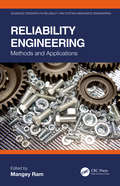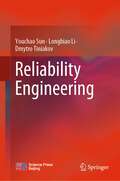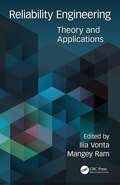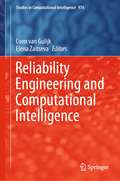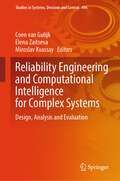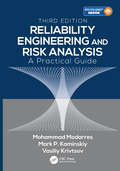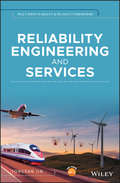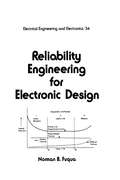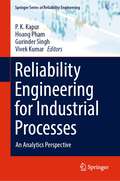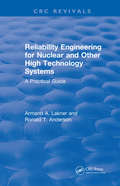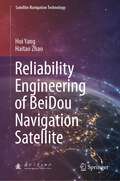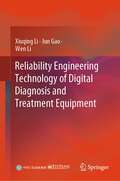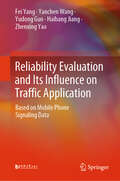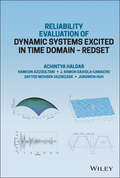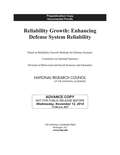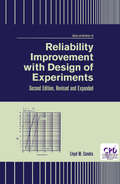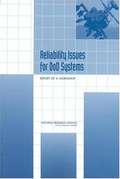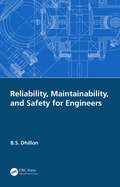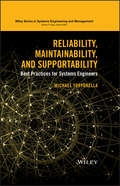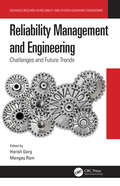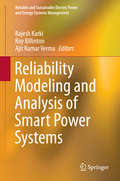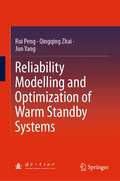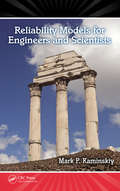- Table View
- List View
Reliability Engineering
by Kailash C. Kapur Michael PechtAn Integrated Approach to Product DevelopmentReliability Engineering presents an integrated approach to the design, engineering, and management of reliability activities throughout the life cycle of a product, including concept, research and development, design, manufacturing, assembly, sales, and service. Containing illustrative guides that include worked problems, numerical examples, homework problems, a solutions manual, and class-tested materials, it demonstrates to product development and manufacturing professionals how to distribute key reliability practices throughout an organization.The authors explain how to integrate reliability methods and techniques in the Six Sigma process and Design for Six Sigma (DFSS). They also discuss relationships between warranty and reliability, as well as legal and liability issues. Other topics covered include:Reliability engineering in the 21st CenturyProbability life distributions for reliability analysisProcess control and process capabilityFailure modes, mechanisms, and effects analysisHealth monitoring and prognosticsReliability tests and reliability estimationReliability Engineering provides a comprehensive list of references on the topics covered in each chapter. It is an invaluable resource for those interested in gaining fundamental knowledge of the practical aspects of reliability in design, manufacturing, and testing. In addition, it is useful for implementation and management of reliability programs.
Reliability Engineering: Probabilistic Models and Maintenance Methods, Second Edition
by Joel A. NachlasWithout proper reliability and maintenance planning, even the most efficient and seemingly cost-effective designs can incur enormous expenses due to repeated or catastrophic failure and subsequent search for the cause. Today’s engineering students face increasing pressure from employers, customers, and regulators to produce cost-efficient designs that are less prone to failure and that are safe and easy to use. The second edition of Reliability Engineering aims to provide an understanding of reliability principles and maintenance planning to help accomplish these goals. This edition expands the treatment of several topics while maintaining an integrated introductory resource for the study of reliability evaluation and maintenance planning. The focus across all of the topics treated is the use of analytical methods to support the design of dependable and efficient equipment and the planning for the servicing of that equipment. The argument is made that probability models provide an effective vehicle for portraying and evaluating the variability that is inherent in the performance and longevity of equipment. With a blend of mathematical rigor and readability, this book is the ideal introductory textbook for graduate students and a useful resource for practising engineers.
Reliability Engineering: Methods and Applications (Advanced Research in Reliability and System Assurance Engineering)
by Mangey RamOver the last 50 years, the theory and the methods of reliability analysis have developed significantly. Therefore, it is very important to the reliability specialist to be informed of each reliability measure. This book will provide historical developments, current advancements, applications, numerous examples, and many case studies to bring the reader up-to-date with the advancements in this area. It covers reliability engineering in different branches, includes applications to reliability engineering practice, provides numerous examples to illustrate the theoretical results, and offers case studies along with real-world examples. This book is useful to engineering students, research scientist, and practitioners working in the field of reliability.
Reliability Engineering
by Youchao Sun Longbiao Li Dmytro TiniakovThis textbook covers the fundamentals of reliability theory and its application for engineering processes, especially for aircraft units and systems. Reliability basis was explained for the best understanding of reliability analysis application for engineering systems in aviation industry. Several approaches for the reliability analysis and their application with examples are presented. It also introduces main trends in the modern reliability theory development.This book will be interested for university students and early-career engineers of aviation industry majors.
Reliability Engineering: Theory and Applications (Advanced Research in Reliability and System Assurance Engineering)
by Ilia Vonta Mangey RamReliability theory is a multidisciplinary science aimed at developing complex systems that are resistant to failures. Reliability engineering has emerged as a main field not only for scientists and researchers, but also for engineers and industrial managers. This book covers the recent developments in reliability engineering. It presents new theoretical issues that were not previously published, as well as the solutions of practical problems and case studies illustrating the applications methodology. This book is written by a number of leading scientists, analysts, mathematicians, statisticians, and engineers who have been working on the front end of reliability science and engineering. <P><P>Reliability Engineering: Theory and Applications covers the recent developments in reliability engineering. It presents new theoretical issues that were not previously presented in the literature, as well as the solutions of important practical problems and case studies illustrating the applications methodology. <P><P>Features <li>Covers applications to reliability engineering practice <li>Discusses current advances and developments <li>Introduces current achievements in the field <li>Considers and analyses case studies along with real world examples <li>Presents numerous examples to illustrate the theoretical results
Reliability Engineering and Computational Intelligence (Studies in Computational Intelligence #976)
by Coen Van Gulijk Elena ZaitsevaComputational intelligence is rapidly becoming an essential part of reliability engineering. This book offers a wide spectrum of viewpoints on the merger of technologies. Leading scientists share their insights and progress on reliability engineering techniques, suitable mathematical methods, and practical applications. Thought-provoking ideas are embedded in a solid scientific basis that contribute to the development the emerging field. This book is for anyone working on the most fundamental paradigm-shift in resilience engineering in decades. Scientists benefit from this book by gaining insight in the latest in the merger of reliability engineering and computational intelligence. Businesses and (IT) suppliers can find inspiration for the future, and reliability engineers can use the book to move closer to the cutting edge of technology.
Reliability Engineering and Computational Intelligence for Complex Systems: Design, Analysis and Evaluation (Studies in Systems, Decision and Control #496)
by Coen Van Gulijk Elena Zaitseva Miroslav KvassayThis book offers insight into the current issues of the merger between reliability engineering and computational intelligence. The intense development of information technology allows for designing more complex systems as well as creating more detailed models of real-world systems which forces traditional reliability engineering approaches based on Boolean algebra, probability theory, and statistics to embrace the world of data science. The works deal with methodological developments as well as applications in the development of safe and reliable systems in various kinds of distribution networks, in the development of highly reliable healthcare systems, in finding weaknesses in systems with the human factor, or in reliability analysis of large information systems and other software solutions. In this book, experts from various fields of reliability engineering and computational intelligence present their view on the risks, the opportunities and the synergy between reliability engineering and computational intelligence that have been developed separately but in recent years have found a way to each other. The topics addressed include the latest advances in computing technology to improve the real lives of millions of people by increasing safety and reliability of various types of real-life systems by increasing the availability of software services, reducing the accident rate of means of transport, developing high reliable patient-specific health care, or generally, save cost and increase efficiency in the work and living environment. Though this book, the reader has access to professionals and researchers in the fields of reliability engineering and computational intelligence that share their experience in merging the two as well as an insight into the latest methods, concerns and application domains.
Reliability Engineering and Risk Analysis: A Practical Guide, Third Edition
by Mohammad Modarres Mark P. Kaminskiy Vasiliy KrivtsovThis undergraduate and graduate textbook provides a practical and comprehensive overview of reliability and risk analysis techniques. Written for engineering students and practicing engineers, the book is multi-disciplinary in scope. The new edition has new topics in classical confidence interval estimation; Bayesian uncertainty analysis; models for physics-of-failure approach to life estimation; extended discussions on the generalized renewal process and optimal maintenance; and further modifications, updates, and discussions. The book includes examples to clarify technical subjects and many end of chapter exercises. PowerPoint slides and a Solutions Manual are also available.
Reliability Engineering and Services (Quality and Reliability Engineering Series)
by Tongdan JinOffers a holistic approach to guiding product design, manufacturing, and after-sales support as the manufacturing industry transitions from a product-oriented model to service-oriented paradigm This book provides fundamental knowledge and best industry practices in reliability modelling, maintenance optimization, and service parts logistics planning. It aims to develop an integrated product-service system (IPSS) synthesizing design for reliability, performance-based maintenance, and spare parts inventory. It also presents a lifecycle reliability-inventory optimization framework where reliability, redundancy, maintenance, and service parts are jointly coordinated. Additionally, the book aims to report the latest advances in reliability growth planning, maintenance contracting and spares inventory logistics under non-stationary demand condition. Reliability Engineering and Service provides in-depth chapter coverage of topics such as: Reliability Concepts and Models; Mean and Variance of Reliability Estimates; Design for Reliability; Reliability Growth Planning; Accelerated Life Testing and Its Economics; Renewal Theory and Superimposed Renewals; Maintenance and Performance-Based Logistics; Warranty Service Models; Basic Spare Parts Inventory Models; Repairable Inventory Systems; Integrated Product-Service Systems (IPPS), and Resilience Modeling and Planning Guides engineers to design reliable products at a low cost Assists service engineers in providing superior after-sales support Enables managers to respond to the changing market and customer needs Uses end-of-chapter case studies to illustrate industry best practice Lifecycle approach to reliability, maintenance and spares provisioning Reliability Engineering and Service is an important book for graduate engineering students, researchers, and industry-based reliability practitioners and consultants.
Reliability Engineering for Electronic Design
by Norman. B. FuquaThis book addresses the needs of electronic design engineers, reliability engineers, and their respective managers, stressing a pragmatic viewpoint rather than a vigorous mathematical presentation.
Reliability Engineering for Industrial Processes: An Analytics Perspective (Springer Series in Reliability Engineering)
by P. K. Kapur Hoang Pham Gurinder Singh Vivek KumarThis book explores how transformative changes driven by the new-age economy can bring about improvements in a company's engineering and manufacturing capabilities. The new-age economy is driven by advanced engineering and manufacturing practices, processes, and technologies, including the Internet of Things (IoT), Cloud Computing, Blockchain, Artificial Intelligence, Robotics, Cyber-Physical Systems (CPS), and Internet-enabled systems to automate industrial processes. Today's business dynamics are governed by uncertainties, disruptions, complexities, and ambiguities that demand quicker and more intelligent decisions. These changes could relate a renaissance in the company's engineering and manufacturing capabilities. To sustain these volatile and ever-changing business dynamics, Industry 4.0 and 5.0 have revolutionized how organizations operate and make intelligent business decisions. Moreover, the extensive role of business analytics has overcome the limitations ofclassical computing through new technologies and intelligent computing methodologies. Over the past few years, much emphasis has been given to investing in developing hardware and programming frameworks for achieving computational intelligence using fuzzy logic, evolutionary computation, neural networks, probabilistic methods, and learning theory. Within this frame of reference, the reliability, quality, and maintenance of complex industrial and manufacturing systems are essential for organizations to utilize them successfully for informed decisions. This book focuses on studies that provide new solutions for system reliability, quality, security, and maintainability using quantitative and qualitative research. It emphasizes developments and problems in systems engineering management, systems integration, software and hardware engineering, and the development process.
Reliability Engineering for Nuclear and Other High Technology Systems: A practical guide (CRC Press Revivals)
by A.A. Lakner R.T. AndersonFirst Published in 2017. This book presents a much needed practical methodology for the establishment of cost-effective reliability programs in nuclear or other high technology industries. Thanks to the high competence and practical experience of the authors in the field of reliability, it vividly illustrates the applicability of proven, cost-effective reliability techniques applied in the American space and military programs as hybridized with the avant-garde approach used by nuclear authorities, utilities and researchers in the United Kingdom and France. This emerged method will support a diligent effort in the enhancement of nuclear safety and protection of the health of the general public. The methodology developed in this book exemplifies the total integrated reliability program approach in the design, procurement, manufacturing, test, installation and operational phases of an equipment life cycle. It is based on lessons learned in space and military programs with certain methodological modifications to enhance practicality. The techniques described here are applicable to college instruction, plant upper and middle management personnel, as well as to regulating agencies with equal benefits; it provides a very pragmatic and cost-efficient approach to the reliability engineering discipline
Reliability Engineering of BeiDou Navigation Satellite (Satellite Navigation Technology)
by Hui Yang Haitao ZhaoThis book describes the reliability research results and experience of BeiDou navigation satellite in engineering development. According to the characteristics of high reliability and high availability, this book discusses the reliability requirements, reliability design, reliability modeling, and reliability analysis of navigation satellite and constellation, focusing on the demonstration and decomposition of reliability requirements, constellation availability design, satellite availability design, and availability analysis. Based on the characteristics of batch production of navigation satellites, the particularity of reliability work is analyzed, and the reliability assurance works during batch production such as process reliability, data consistency comparison, storage reliability, and redundant satellite demonstration are introduced.This book is suitable for spacecraft developers, as well as postgraduates majoring in spacecraft engineering, quality, or reliability.
Reliability Engineering Technology of Digital Diagnosis and Treatment Equipment
by Xiuqing Li Jun Gao Wen LiThis book focuses on the reliability engineering of medical devices, especially digital diagnosis and treatment equipment in China. It details the professional technologies and application methods of reliability design analysis, fault model analysis and reliability test of digital diagnosis and treatment equipment, to meet the needs of project undertakers of digital diagnosis and treatment equipment. From the three aspects: safety analysis and EMC design protection, material selection and control, and software engineering and quality, this book provides professional and technical ideas and methods of reliability for the quality problems prone to occur in the field of medical devices, as well as method guidance for readers. Meanwhile, it runs through the whole process of design, engineering, testing, production and management of all digital diagnosis and treatment equipment research and development enterprises and even product R & D enterprises in the field of medicaldevices. It is used as reading materials for personnel of testing institutions and evaluation institutions in medical devices.
Reliability Evaluation and Its Influence on Traffic Application: Based on Mobile Phone Signaling Data
by Fei Yang Yanchen Wang Yudong Guo Haihang Jiang Zhenxing YaoTraditional resident travel surveys have limited the development of traffic planning theory and traffic model technology. Although mobile phone signaling data has been widely used to analyze macro urban travel characteristics, travel patterns, and travel behavior due to the advantages such as wide coverage, dynamic performance, and low collection costs, its potential and reliability in collecting individual travel chain information lacked demonstration and consensus. This book aims to explore a set of methods to extract travel chain information based on the intensive base station under 4G/5G mobile communication network systems. It then verifies the reliability of constructed models from multiple perspectives by integrating empirical research and simulation technologies. Finally, it analyzes the influence of reliability on engineering practice from the perspective of traffic models. By demonstrating the availability of travel information extraction technology, this book provides a systematic and objective reference for traffic practitioners, which enhances their trust in related big data analysis technologies in traffic engineering. It also provides a solid foundation for optimizing and reconstructing theoretical traffic models, urban traffic planning, management, and decision-making. This book helps traffic engineering researchers, technicians, and managers better understand the difficulties and challenges associated with the application of signaling data. It also helps them better evaluate the impact of existing data types and extraction methods on the four-step method, and adapt to changes in traffic demand and technological environment to achieve theoretical innovation and technological reform.
Reliability Evaluation of Dynamic Systems Excited in Time Domain - Redset: Alternative to Random Vibration and Simulation
by Achintya Haldar Hamoon Azizsoltani J. Ramon Gaxiola-Camacho Sayyed Mohsen Vazirizade Jungwon HuhRELIABILITY EVALUATION OF DYNAMIC SYSTEMS EXCITED IN TIME DOMAIN – REDSET Multi-disciplinary approach to structural reliability analysis for dynamic loadings offering a practical alternative to the random vibration theory and simulation Reliability Evaluation of Dynamic Systems Excited in Time Domain – REDSET is a multidisciplinary concept that enables readers to estimate the underlying risk that could not be solved in the past. The major hurdle was that the required limit state functions (LSFs) are implicit in nature and the lack of progress in the reliability evaluation methods for this class of problems. The most sophisticated deterministic analysis requires that the dynamic loadings must be applied in the time domain. To satisfy these requirements, REDSET is developed. Different types and forms of dynamic loadings including seismic, wind-induced wave, and thermomechanical loading in the form of heating and cooling of solder balls used in computer chips are considered to validate REDSET. Time domain representations and the uncertainty quantification procedures including the use of multiple time histories are proposed and demonstrated for all these dynamic loadings. Both onshore and offshore structures are used for validation. The potential of REDSET is demonstrated for implementing the Performance Based Seismic Design (PBSD) concept now under development in the United States. For wider multidisciplinary applications, structures are represented by finite elements to capture different types of nonlinearity more appropriately. Any computer program capable of conducting nonlinear time domain dynamic analysis can be used, and the underlying risk can be estimated with the help of several dozens or hundreds of deterministic finite element analyses, providing an alternative to the simulation approach. To aid comprehension of REDSET, numerous illustrative examples and solution strategies are presented in each chapter. Written by award-winning thought leaders from academia and professional practice, the following sample topics are included: Fundamentals of reliability assessment including set theory, modeling of uncertainty, the risk-based engineering design concept, and the evolution of reliability assessment methods Implicit performance or limit state functions are expressed explicitly by the extensively modified response surface method with several new experimental designs Uncertainty quantification procedures with multiple time histories for different dynamic loadings, illustrated with examples The underlying risk can be estimated using any computer program representing structures by finite elements with only few deterministic analyses REDSET is demonstrated to be an alternative to the classical random vibration concept and the basic simulation procedure for risk estimation purposes REDSET changes the current engineering design paradigm. Instead of conducting one deterministic analysis, a design can be made more dynamic load tolerant, resilient, and sustainable with the help of a few additional deterministic analyses This book describing REDSET is expected to complement two other books published by Wiley and authored by Haldar and Mahadevan: Probability, Reliability and Statistical Methods in Engineering Design and Reliability Assessment Using Stochastic Finite Element Analysis. The book is perfect to use as a supplementary resource for upper-level undergraduate and graduate level courses on reliability and risk-based design.
Reliability Growth: Enhancing Defense System Reliability
by Panel on Reliability Growth Methods for Defense SystemsA high percentage of defense systems fail to meet their reliability requirements. This is a serious problem for the U. S. Department of Defense (DOD), as well as the nation. Those systems are not only less likely to successfully carry out their intended missions, but they also could endanger the lives of the operators. Furthermore, reliability failures discovered after deployment can result in costly and strategic delays and the need for expensive redesign, which often limits the tactical situations in which the system can be used. Finally, systems that fail to meet their reliability requirements are much more likely to need additional scheduled and unscheduled maintenance and to need more spare parts and possibly replacement systems, all of which can substantially increase the life-cycle costs of a system. Beginning in 2008, DOD undertook a concerted effort to raise the priority of reliability through greater use of design for reliability techniques, reliability growth testing, and formal reliability growth modeling, by both the contractors and DOD units. To this end, handbooks, guidances, and formal memoranda were revised or newly issued to reduce the frequency of reliability deficiencies for defense systems in operational testing and the effects of those deficiencies. "Reliability Growth" evaluates these recent changes and, more generally, assesses how current DOD principles and practices could be modified to increase the likelihood that defense systems will satisfy their reliability requirements. This report examines changes to the reliability requirements for proposed systems; defines modern design and testing for reliability; discusses the contractor's role in reliability testing; and summarizes the current state of formal reliability growth modeling. The recommendations of "Reliability Growth" will improve the reliability of defense systems and protect the health of the valuable personnel who operate them.
Reliability Improvement with Design of Experiment, Second Edition, (Quality and Reliability)
by Lloyd CondraA guide to implementing and operating a practical reliability program using carefully designed experiments to provide information quickly, efficiently and cost effectively. It emphasizes real world solutions to daily problems. The second edition contains a special expanded section demonstrating how to combine accelerated testing with design of experiments for immediate improvement.
Reliability Issues for DoD Systems: REPORT OF A WORKSHOP
by Committee on National StatisticsA report on Reliability Issues for DoD Systems
Reliability, Maintainability, and Safety for Engineers
by B.S. DhillonTo meet the needs of today, engineered products and systems are an important element of the world economy, and each year billions of dollars are spent to develop, manufacture, operate, and maintain various types of products and systems around the globe. This book integrates and combines three of those topics to meet today’s needs for the engineers working in these fields. This book provides a single volume that considers reliability, maintainability, and safety when designing new products and systems. Examples along with their solutions are placed at the end of each chapter to test readers’ comprehension. The book is written in a manner that readers do not need any previous knowledge of the subject, and many references are provided. This book is also useful to many people, including design engineers, system engineers, reliability specialists, safety professionals, maintainability engineers, engineering administrators, graduate and senior undergraduate students, researchers, and instructors.
Reliability, Maintainability, and Supportability
by Michael TortorellaFocuses on the core systems engineering tasks of writing, managing, and tracking requirements for reliability, maintainability, and supportability that are most likely to satisfy customers and lead to success for suppliers This book helps systems engineers lead the development of systems and services whose reliability, maintainability, and supportability meet and exceed the expectations of their customers and promote success and profit for their suppliers. This book is organized into three major parts: reliability, maintainability, and supportability engineering. Within each part, there is material on requirements development, quantitative modelling, statistical analysis, and best practices in each of these areas. Heavy emphasis is placed on correct use of language. The author discusses the use of various sustainability engineering methods and techniques in crafting requirements that are focused on the customers' needs, unambiguous, easily understood by the requirements' stakeholders, and verifiable. Part of each major division of the book is devoted to statistical analyses needed to determine when requirements are being met by systems operating in customer environments. To further support systems engineers in writing, analyzing, and interpreting sustainability requirements, this book also Contains "Language Tips" to help systems engineers learn the different languages spoken by specialists and non-specialists in the sustainability disciplines Provides exercises in each chapter, allowing the reader to try out some of the ideas and procedures presented in the chapter Delivers end-of-chapter summaries of the current reliability, maintainability, and supportability engineering best practices for systems engineers Reliability, Maintainability, and Supportability is a reference for systems engineers and graduate students hoping to learn how to effectively determine and develop appropriate requirements so that designers may fulfil the intent of the customer.
Reliability Management and Engineering: Challenges and Future Trends (Advanced Research in Reliability and System Assurance Engineering)
by Harish Garg Mangey RamReliability technology plays an important role in the present era of industrial growth, optimal efficiency, and reducing hazards. This book provides insights into current advances and developments in reliability engineering, and the research presented is spread across all branches. It discusses interdisciplinary solutions to complex problems using different approaches to save money, time, and manpower. It presents methodologies of coping with uncertainty in reliability optimization through the usage of various techniques such as soft computing, fuzzy optimization, uncertainty, and maintenance scheduling. Case studies and real-world examples are presented along with applications that can be used in practice. This book will be useful to researchers, academicians, and practitioners working in the area of reliability and systems assurance engineering. Provides current advances and developments across different branches of engineering. Reviews and analyses case studies and real-world examples. Presents applications to be used in practice. Includes numerous examples to illustrate theoretical results.
Reliability Modeling and Analysis of Smart Power Systems
by Rajesh Karki Roy Billinton Ajit Kumar VermaThe volume presents the research work in understanding, modeling and quantifying the risks associated with different ways of implementing smart grid technology in power systems in order to plan and operate a modern power system with an acceptable level of reliability. Power systems throughout the world are undergoing significant changes creating new challenges to system planning and operation in order to provide reliable and efficient use of electrical energy. The appropriate use of smart grid technology is an important drive in mitigating these problems and requires considerable research activities, some of which (by researchers from academia and industry) are included in this volume: the reliability appraisal of smart grid technologies and their applications, micro-grids, assessment of plug-in hybrid vehicles and the system effects, smart system protection and reliability evaluation, demand response and smart maintenance of power system equipment.
Reliability Modelling and Optimization of Warm Standby Systems
by Rui Peng Qingqing Zhai Jun YangThis book introduces the reliability modelling and optimization of warm standby systems. Warm standby is an attractive redundancy technique, as it consumes less energy than hot standby and switches into the active state faster than cold standby. Since a warm standby component experiences different failure rates in the standby state and active state, the reliability evaluation is challenging and the existing works are only restricted to very special cases. By adapting the decision diagrams, this book proposes the methodology to evaluate the reliability of different types of warm standby systems and studies the reliability optimization. Compared with existing works, the proposed methods allow the system to have an arbitrary number of components and allow the failure time distribution of components to observe arbitrary distributions. From this book, the readers can not only learn how to evaluate and optimize the reliability of warm standby systems but also use the methods to study the reliability of other complex systems.
Reliability Models for Engineers and Scientists
by Mark P. KaminskiyA discussion of the basic reliability concepts and models, Reliability Models for Engineers and Scientists demystifies modern mathematical reliability models. Requiring very little mathematical background on the reader's part, this concise book introduces the models by focusing on their physical meaning and the supporting data; it then goes on to p
